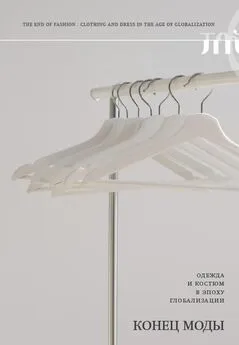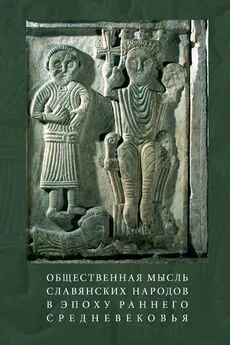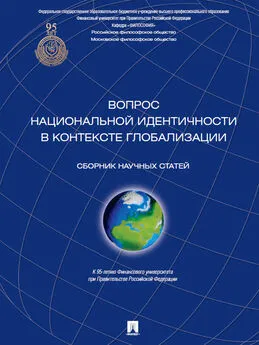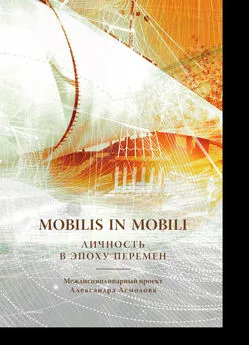Коллектив авторов - Конец моды. Одежда и костюм в эпоху глобализации
- Название:Конец моды. Одежда и костюм в эпоху глобализации
- Автор:
- Жанр:
- Издательство:Литагент НЛО
- Год:2020
- Город:Москва
- ISBN:9785444814048
- Рейтинг:
- Избранное:Добавить в избранное
-
Отзывы:
-
Ваша оценка:
Коллектив авторов - Конец моды. Одежда и костюм в эпоху глобализации краткое содержание
Конец моды. Одежда и костюм в эпоху глобализации - читать онлайн бесплатно ознакомительный отрывок
Интервал:
Закладка:
548
Strasser S. Waste and Want: A Social History of Trash. New York: Holt, 1999. Pp. 188–189.
549
Faster, Cheaper Fashion // Economist. 2015. September 5. www.economist.com/news/business/21663221-rapidly-rising-super-cheap-irish-clothes-retailerprepares-conquer-america-rivals-should .
550
The True Cost. DVD. Dir. Andrew Morgan. USA: Bullfrog Films, 2015.
551
Burke J. Bangladesh Factory Collapse Leaves Trail of Shattered Lives // Guardian. 2013. June 6; Sinkovics N., Ferdous Hoque S., Sinkovics R. R. Rana Plaza Collapse Aftermath: Are CSR Compliance and Auditing Pressures Effective? // Accounting, Auditing and Accountability Journal. 2016. 29, no. 4. Pp. 624–625.
552
Taplin I. M. Who Is to Blame? A Re-examination of Fast Fashion after the 2013 Factory Disaster in Bangladesh // Critical Perspectives on International Business. 2014. 10, no. 1/2. P. 77.
553
D’Ambrogio E. European Parliamentary Research Service. Workers’ Conditions in the Textile and Clothing Sector: Just an Asian Affair? Issues at Stake after the Rana Plaza Tragedy. Briefing, European Parliament. 2014. August. www.europarl.europa.eu/EPRS/140841REV1-Workers-conditions-in-the-textile-and-clothing-sector-just-an-Asian-affair-FINAL.pdf (accessed 26.06.2017).
554
Taplin. Who Is to Blame? P. 79.
555
Sinkovics, Hoque, Sinkovics. Rana Plaza Collapse Aftermath. P. 624.
556
Le Zotte. Goodwill to Grunge.
557
Faster, Cheaper Fashion.
558
О том, как норвежские СМИ освещали катастрофу с «Рана-Плаза», см.: Orgeret S. K. Cheap Clothes: Distant Disasters. Journalism Turning Suffering into Practical Action // Journalism. 2016. Pp. 1–18.
559
Sluiter. Clean Clothes. P. 20.
560
Там же. С. 48–49.
561
Diner H. R. Roads Taken: The Great Jewish Migrations to the New World and the Peddlers Who Forged the Way. New Haven, CT: Yale University Press, 2015; Von Drehle D. Triangle: The Fire That Changed America. New York: Grove Press, 2003.
562
Green. Ready-to-Wear. Pp. 80–86, 97–104.
563
Glickman L. B. Buying Power: A History of Consumer Activism in America. Chicago: Chicago University Press, 2009.
564
Glickman. «Make Lisle the Style». Pp. 573–608.
565
Hirschmann A. O. Exit, Voice, and Loyalty: Responses to Decline in Firms, Organizations, and States. Cambridge, MA: Harvard University Press, 1972.
566
Glickman. Buying Power. Pp. 297–310.
567
Sluiter. Clean Clothes.
568
Chessel. Women and the Ethics of Consumption. Pp. 81–98.
569
Кляйн Н. No Logo. Люди против брендов. М.: Добрая книга, 2008.
570
Bairoch P. Victoires et déboires: Histoire économique et sociale du monde du XVIe siècle а nos jours. Vol. 3. Paris: Gallimard, 1997.
571
Holson L.M., Abrams R. For the Trumps, «Made in U. S.A.» May Be a Tricky Label to Stitch // New York Times. 2016. December 28. www.nytimes.com/2016/12/28/business/donald-trump-ivankaclothes-global-trade-overseas-manufacturing.html (accessed 15.05.2017).
572
Bender D., Greenwald R. A. Sweatshop USA: The American Sweatshop in Historical and Global Perspective. New York: Routledge, 2003.
573
Sluiter. Clean Clothes. P. 71.
574
Taplin. Who Is to Blame? P. 78.
575
Davidson A. Economic Recovery, Made in Bangladesh? // New York Times. 2013. May 14. MM16.
576
Green. Ready-to-Wear; Bender, Greenwald. Sweatshop USA.
577
Sluiter. Clean Clothes.
578
Sen S., Battacharya C. B. Does Doing Good Always Lead to Doing Better? Consumer Reactions to Corporate Social Responsibility // Journal of Marketing Research. 2001. 38, no. 2. P. 240.
579
Taplin. Who Is to Blame? P. 76.
580
Lund-Thomsen P., Lindgreen A. Corporate Social Responsibility in Global Value Chains: Where Are We Now and Where Are We Going? // Journal of Business Ethics. 2014. 123, no. 1. P. 13.
581
Ibid. P. 12.
582
McAfee, Dessain, Sjöman. Zara.
583
Mikalsen K.-E. Nordea-sjef: Dette ville en skjorte kostet om fabrikkarbeiderne i Bangladesh skulle fatt en levelig lonn //Aftenposten. 2017. June 2. www.aftenposten.no/okonomi/Nordea-sjef-Dette-ville-en-skjortekostet-om-fabrikkarbeiderne-i-Bangladesh-skulle-fatt-en-levelig-lonn-622467b.html (accessed 02.06.2017).
584
Taplin. Who Is to Blame? P. 78; Rafael R. Is This Sewing Robot the Future of Fashion? // Fast Company. 2017. January 24. www.fastcompany.com/3067149/is-this-sewing-robot-the-future-of-fashion (accessed 02.06.2017).
585
Godley. Selling the Sewing Machine. Pp. 266–314.
586
Hoskins T. Robot Factories Could Threaten Jobs of Millions of Garment Workers // Guardian. 2016. July 16. www.theguardian.com/sustainable-business/2016/jul/16/robot-factories-threaten-jobsmillions-garment-workers-south-east-asia-women (accessed 02.06.2017).
587
Taplin. Who Is to Blame? Pp. 76–78; Glickman. Buying Power. Pp. 294–296.
588
Falasca-Zamponi. Waste and Consumption. Pp. 36–39, 42–49.
589
Аббревиатура Y2K расшифровывается следующим образом: Y – year (год), 2 – два знака для обозначения года (из‐за которых и возник риск сбоя компьютерных систем при наступлении нового тысячелетия), K – kilo (приставка, употребляемая в системе СИ для единиц, превышающих основную единицу измерения в 1000 раз). ( Прим. пер. )
590
The Editors of Encyclopedia Britannica. Y2K Bug. Last modified 2017. April 20. www.britannica.com/technology/Y2K-bug (accessed 26.08.2017).
591
Agins T. The End of Fashion, How Marketing Changed the Clothing Business Forever. New York: Quill, 2000. P. 15.
592
Ibid.
593
Ibid. P. 14.
594
Vinken. Fashion Zeitgeist. P. 35.
595
Ibid.
596
Breward Ch. Foreword // Fashion Studies: Research Methods and Practices / Еd. H. Jenss. London; New York: Bloomsbury, 2016. P. xviii.
597
Ibid.
598
Buckley Ch., Clark H. Fashion and Everyday Life, London and New York. London; New York: Bloomsbury, 2017. P. 235.
599
Breward. Foreword. P. xvii.
600
Edelkoort L. Anti_Fashion: A Manifesto for the Next Decade. Paris: Trend Union, 2014.
601
Krauss R. E. Sculpture in the Expanded Field // The Originality of the Avant-Garde and Other Modernist Myths. Cambridge, MA: The MIT Press, 1985. P. 279.
602
Цит. по: Breward. Foreword. P. xix.
603
Bugg J. Fashion at the Interface: Designer-Wearer-Viewer // Fashion Practice. 2009. 1, no. 1. P. 10.
604
Ibid. Р. 10–11.
605
См.: Vänskä A., Clark H. (eds) Fashion Curating: Critical Practice in the Museum and Beyond. London; New York: Bloomsbury, 2017.
606
Bugg. Fashion at the Interface. P. 13.
607
См., например: Taylor L. Establishing Dress History. Manchester; New York: Manchester University Press, 2004; Steele V., Palmer A. (eds) Exhibitionism (Special Issue). Fashion Theory: The Journal of Dress, Body & Culture. 2008. Vol. 12.1; Anderson F. Museums as Fashion Media // Fashion Cultures: Theories, Explorations and Analysis / Еd. S. Bruzzi. London; New York: Routledge, 2000. Pp. 371–389.
608
Žiźek S. Living in the End Times. London; New York: Verso, 2010.
609
Buckley Ch., Clark H. In Search of the Everyday: Museums, Collections, and Representations of Fashion in London and New York // Fashion Studies: Research Methods and Practices / Еd. H. Jenss. London; New York: Bloomsbury, 2016. P. 27.
610
Clark J., De La Haye A. Exhibiting Fashion: Before and after 1971. New Haven, CT: Yale University Press, 2014.
611
De La Haye A. Vogue and the V&A Vitrine // Fashion Theory: The Journal of Dress, Body & Culture. 2006. Vol. 10.1/2. Pp. 132–133.
612
Breward Ch. Between the Museum and the Academy: Fashion Research and Its Constituencies // Fashion Theory: The Journal of Dress, Body & Culture. 2008. Vol. 12.1. P. 91. На русском языке: Бруард К. Между музеем и академией: исследования в области моды и «заинтересованные стороны» // Теория моды: одежда, тело, культура. 2006. № 29. С. 175–188. 2006. № 29. С. 175–188.
613
Там же.
614
Там же. См. также: Crawley G., Barbieri D. Dress, Time, and Space: Expanding the Field through Exhibition Making // The Handbook of Fashion Studies / Еd. S. Black et al. London; New York: Bloomsbury, 2013. Pp. 44–60.
615
Steele V. Museum Quality. The Rise of the Fashion Exhibition // Exhibitionism (Special Issue). Fashion Theory: The Journal of Dress, Body & Culture. 2008. Vol. 12.1. P. 28.
616
Crawley, Barbieri. Dress, Time and Space. P. 58.
617
Те, кому интересны подробности, могут ознакомиться с очень ценным «Неполным перечнем» посвященных моде выставок за 1971–2013 годы, составленным Джефри Хорсли, см.: Clark, de la Haye. Exhibiting Fashion. Pp. 169–245.
618
Palmer A. Reviewing Fashion Exhibitions // Exhibitionism (Special Issue). Fashion Theory: The Journal of Dress, Body & Culture. 2008. Vol. 12.1. P. 123.
619
Petrov J. Exhibition and Catalog Review: The Concise Dictionary of Dress // Fashion Theory: The Journal of Dress, Body & Culture. 2010. Vol. 16.1. Pp. 109–116.
Читать дальшеИнтервал:
Закладка:










